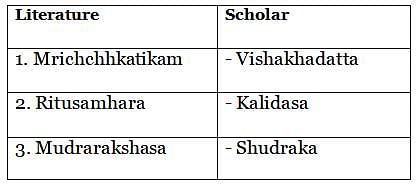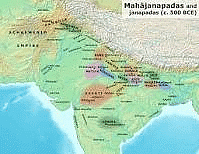CGPSE Prelims Paper 1 Mock Test - 4 - CGPSC (Chhattisgarh) MCQ
30 Questions MCQ Test - CGPSE Prelims Paper 1 Mock Test - 4
Consider the following regions of ancient Indian history:
1. Kosala
2. Magadha
3. Gandhara
4. Avanti
5. Panchala
Which of the above was/were the ‘Mahajanapadas’?
What is the primary reason for the Muria tribe's displacement from the Dandakaranya region of Chhattisgarh?
| 1 Crore+ students have signed up on EduRev. Have you? Download the App |
What does the term 'Internally Displaced People' (IDPs) refer to?
What significant ruling did the Supreme Court of India make regarding the Salwa Judum in 2011?
Which language is primarily spoken by the Muria tribe?
What operation resulted in the elimination of 29 Naxalites in Chhattisgarh?
What is the primary focus of the Greyhound commandos in Andhra Pradesh?
What was the original cause of the Naxal movement in India?
Which major river system ranks as the largest in Odisha?
What significant feature of the Mahanadi River is recognized as the longest dam in India?
What are the primary industrial activities found in the Mahanadi basin?
What is the primary objective of left-wing extremist groups in India?
How many polling stations were set up for the Lok Sabha elections in the Bastar constituency?
What are the key characteristics of the Muria tribe's social structure?
What was the significance of the Mahanadi Water Disputes Tribunal established in 2018?
Which of the following best describes the Maoist ideology?
Sangam texts cover the social evolution of Tamil people. In this context, which of the following statements given below is/are not correct?
1. The narrative texts show that early Tamil people were primarily pastoral.
2. No reference to trade and economic activities has been made in these texts.
Select the correct answer using the code given below:
Consider the following statements:
Ajivikas were fatalists who believed that everything was predetermined.
Lokayatas were materialists who rejected the authority of the Vedas.
Makkhali Gosala was an Ajivika teacher and Ajita Kesakambalin was a lokayata teacher.
Which of the statements given above is/are correct?
Which of the following steps were taken by rulers in the medieval times to earn support of their subjects?
Declaring their close relationship with god through titles like “Shadow of God”.
Constructing public buildings like markets and water tanks.
Offering patronage to the learned and pious people.
Select the correct answer using the code given below.
Consider the following statements regarding Sultan Mahmud of Ghazni
- He entrusted a scholar, Al-Biruni to write an account of the subcontinent.
- Sultan Mahmud of Ghazni was a contemporary of Rajendra I.
- The Chahamana ruler Prithviraja III defeated an Afghan ruler named Sultan Mahmud of Ghazni.
Which of the statements given above are correct?
With reference to the Indus Valley Civilization, which one of the following statements is not correct?
With reference to Medieval India, consider the following pairs :

Q. How many pairs given above is/are correctly matched?
Consider the following pairs with reference to the cultural History of India :

How many pairs given above is/are correctly matched ?
Which of the following statements is/are correct about the currency reforms of Muhammad-Bin-Tughlaq?
1. Token currency was introduced for the first time ever in the history during his reign.
2. He introduced a bronze coin with the same value as the silver tanka.
Select the correct answer using the code given below:
In the context of mural paintings in ancient India, consider the following statements:
1. Paintings at the Kanchipuram temple were patronised by the Pallavas.
2. Paintings at Jaina caves in Sittanavasal were patronised by the Pandyas.
3. Mural painting as an art declined during the reign of the Cholas.
Which of the statements given above is/are Correct?
Who established the “Atmiya Sabha” a precursor in the socio-religious reforms in Bengal?
Consider the following statements:
1. In 1863, Satyendra Prasad Sinha became the first Indian to qualify for the Indian Civil Service.
2. The Indian Police Act, 1861, created a setup for an All India Police.
3. The 1853 Charter Act ended the Company’s patronage, enjoining recruitment to be through an open competition.
Which of the statements given above is/are Correct?
With reference to Colonial powers in India, arrange the following treaties in chronological order:
Treaty of Aix-La Chapelle
Treaty of peace of Paris
Treaty of Ryswick
Select the correct answer using the code given below:
Consider the following statements with respect to Simon Commission:
All the members of the Commission were Englishmen.
The Commission was appointed to go into the question of further constitutional reforms in British India.
The Simon Commission report recommended dominion status for British India.
Which of the statements given above are correct?
Consider the following pairs :
Places - Historical events
1. Varanasi - Annie Besant established the Central Hindu College
2. Mathura - A temple dedicated to Mother India was inaugurated by Mahatma Gandhi.
3. Bardoli - Withdrawal of Non Cooperation Movement
4. Lucknow - An armed robbery was organized by ten revolutionaries of the Hindustan Republic Association
How many pairs given above is/are correctly matched ?


















